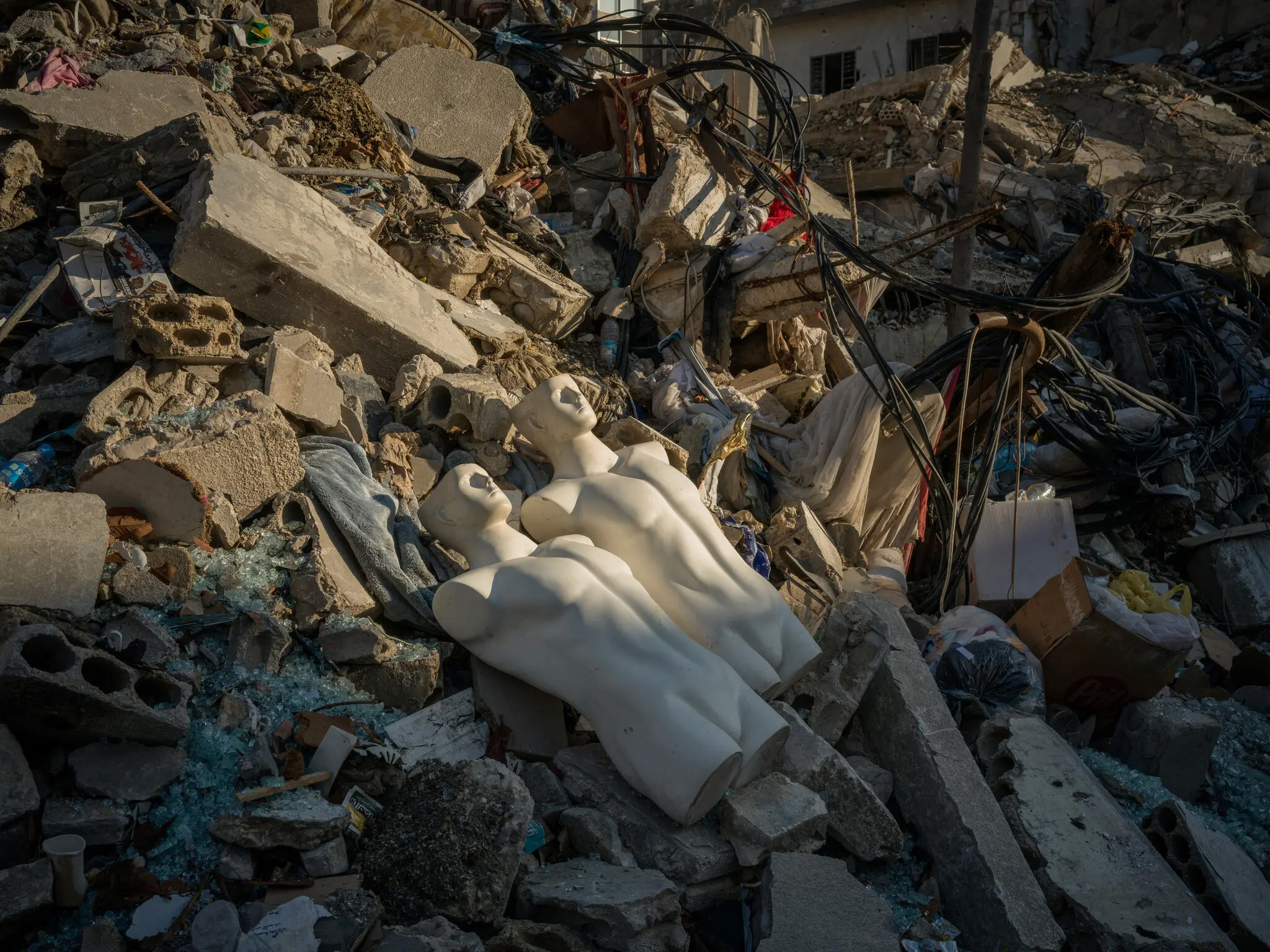The remains of a clothing store destroyed by Israeli raids on a market in Nabatieh, photographed by Laura Boushnak/NYT.
Yara Nahle, a Lebanese writer, begins her blog with the image of the ‘angel of history,’ described by the German philosopher Walter Benjamin (1892-1940) as a figure who “sees only one catastrophe, a pile of rubble before his feet." For Benjamin, history is not a continuous progression toward the future but a pile of ruins accumulated by wars, conflicts, and disasters.
"Ruins" has more meaning for Benjamin than its literal definition, which combines rubble and destruction. To understand the ruins and destruction, rebuilding and construction are necessary. Nahle’s essay “In the Presence of Rubble,” published in Al Modon, exposes one to history while simultaneously presenting an opportunity to think about rebuilding anew and implementing the cautionary lessons to avoid future wars. Nahle implies that rebuilding efforts following the 2006 war were flawed and failed to prevent the conflict in 2024.
Historical knowledge is necessary to fully grasp what she means when she says, "There is no document of civilization that is not also a document of barbarism," a nod to philosopher Walter Benjamin’s “Theses on the Philosophy of History.” It suggests that every achievement or artifact of civilization — cultural, intellectual, or material — bears traces of the suffering, oppression, or exploitation that made it possible. Civilizations, for example, are said to have achieved progress through practices that could be considered barbaric, such as slavery, colonization, or war. Another historical example is the magnificent architectural works like the pyramids of Egypt or industrial advancements in the 19th century, which were often built on the backs of exploited labor. Nahle illustrates these examples when she quotes Benjamin: "Every great building bears the traces of the ruin that preceded it, and every prosperous city conceals within its streets the memory of suffering." In the same logic, civilization is rooted in conflict or war and the ruin that preceded it.
The infatuation with military details can be traced to young generations. Nahle draws from memories of her youth: “Our enthusiasm grew so intense that the destruction significantly determined the winning village in the 2006 War. One of them shouted, “The first house destroyed by the war was in our village.” Then the teacher stopped us in astonishment: “Are you competing over who got the most destruction?” This line of discussion among the seventh graders continued until the teacher protested by questioning the wisdom of competing between whose village got the "most destruction."’
Nahle laments that despite two wars having come and gone, no lessons have been learned, and only ruins remain. She writes, "Eighteen years separate my first and second tours amidst the ruins of my city, Nabatieh. Nearly two decades have passed, and the destruction remains the most transparent and tangible expression of our shared experience." Urbanization swept across the ruins. The rubble was cleared away. Still, the country returned to continue "our struggles on a blank page, ready to be stained with blood and dust in the next war."
The recent war proves no lessons were learned, leaving only wishful thinking. In the words of Nahle: "And so it was. The expected war came because wars in troubled Lebanon are always likely to scatter what has been built over two decades and what even goes back a century. Given all this, we can only wonder: When will the third round come?" The recent war has destroyed all that has been accomplished between the 2006 and 2024 wars.
Consistent with the reconstruction promises, the people in the South and across the country were told, "We will make it [the destroyed villages and towns] more beautiful than they were before." This was the popular slogan of the post-war reconstruction phase. However, a repeat of the post-2006 reconstruction is bound to fail, according to Nahle: "The reality, however, says otherwise because money, cement, and urban plans are insufficient to gather the city's fragments and rearrange them as a house or a homeland."
Many returning to the South, the Beqaa, and the Beirut southern suburbs feel “alienated” amidst the rubble of their homes and villages, especially since they have become “exposed to the storm of history.” Although this is not their first experience with destruction, it is the most revealing truth, for “in this vicious cycle of destruction followed by construction, many wonder about the point of rebuilding a house or a city that will be subject to future conflicts and settlements.”
Something draws the residents of the destroyed areas today to their ruined cities and villages, perhaps an incomplete attempt to survive. According to Nahle, ‘place’ loses its temporal or functional meaning and is transformed into a space for contemplation and dreams. She writes, “In awe, they stand on the ruins, trying to restore them in their minds. Memory fails them as everything else has. Amidst the rubble, silence reigns, or rather, the sound of time losing itself.”
But with tragedy overpowering dreams, something we did not experience in the previous war, this time, “letting go of the ruins is difficult.” The author cites the renowned Irish author, James Joyce, "Absence is the highest form of presence." If this statement has a physical embodiment, “it is the rubble, that symbolic space that combines presence and absence,” writes Nahle.
The most telling statement within Nahle’s essay is this: “The most challenging moment in the life of any building, after its destruction, is when its rubble is removed and its dust is swept away. Despite the difference in intentions, the Bobcat is no less violent than the warplane. In removing the wreckage, it buries the last witness to a life that was here and is no longer there.”
The original Arabic blog post, “In the Presence of Rubble” by Yara Nahle, appeared in Al Modon.
Copyright © 2025 AL JADID MAGAZINE

